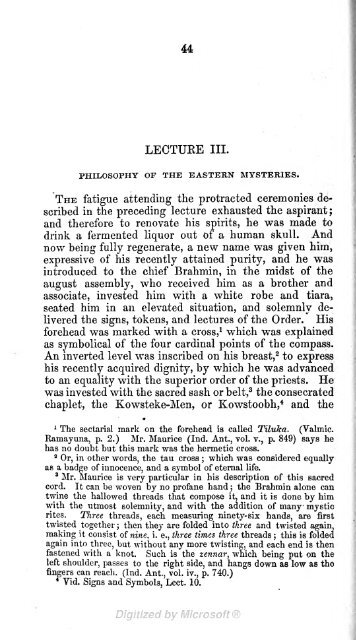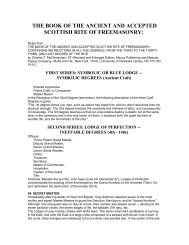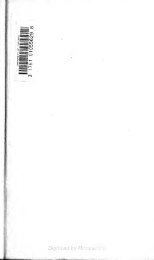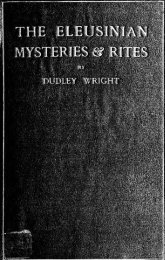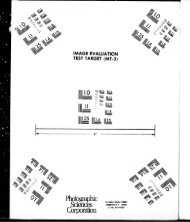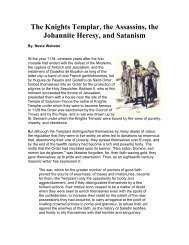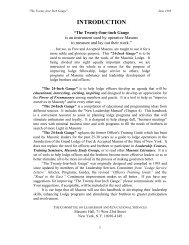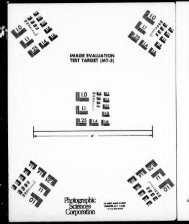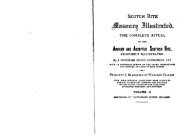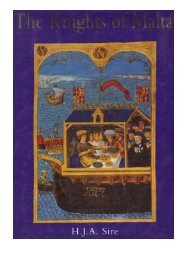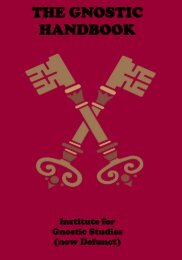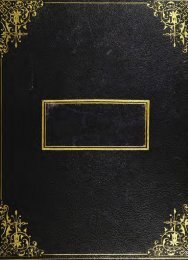The History of Initiation - The Masonic Trowel
The History of Initiation - The Masonic Trowel
The History of Initiation - The Masonic Trowel
You also want an ePaper? Increase the reach of your titles
YUMPU automatically turns print PDFs into web optimized ePapers that Google loves.
44<br />
LECTURE III.<br />
PHILOSOPHY OF THE EASTERN MYSTERIES.<br />
THE fatigue attending the protracted ceremonies described<br />
in the preceding lecture exhausted the aspirant ;<br />
and therefore to renovate his spirits, he was made to<br />
drink a fermented liquor out <strong>of</strong> a human skull. And<br />
now being fully regenerate, a new name was given him,<br />
expressive <strong>of</strong> his recently attained purity, and he was<br />
introduced to the chief Brahmin, in the midst <strong>of</strong> the<br />
august assembly, who received him as a brother and<br />
associate, invested him with a white robe and tiara,<br />
seated him in an elevated situation, and solemnly delivered<br />
the signs, tokens, and lectures <strong>of</strong> the Order. His<br />
forehead was marked with a cross, 1 which was explained<br />
as symbolical <strong>of</strong> the four cardinal points <strong>of</strong> the compass.<br />
An inverted level was inscribed on his breast, 2 to express<br />
his recently acquired dignity, by which he was advanced<br />
to an equality with the superior order <strong>of</strong> the priests. He<br />
was invested with the sacred sash or belt, 3 the consecrated<br />
chaplet, the Kowsteke-Men, or Kowstoobh, 4 and the<br />
*<br />
1 <strong>The</strong> sectarial mark on the forehead is called Tiluka. (Valmic.<br />
Ramayuna, p. 2.) Mr. Maurice (Ind. Ant., vol. v., p. 849) says he<br />
has no doubt but this mark was the hermetic cross.<br />
2<br />
Or, in other words, the tau cross which was considered ;<br />
equally<br />
as a badge <strong>of</strong> innocence, and a symbol <strong>of</strong> eternal life.<br />
3 Mr. Maurice is very particular in his description <strong>of</strong> this sacred<br />
the Brahmin alone can<br />
cord. It can be woven by no pr<strong>of</strong>ane hand ;<br />
twine the hallowed threads that compose it, and it is done by him<br />
with the utmost solemnity, and with the addition <strong>of</strong> many mystic<br />
rites. Three threads, each measuring ninety-six hands, are first<br />
twisted together then ; they are folded into three and twisted again,<br />
making it consist <strong>of</strong> nine, i. e., three times three threads this is folded<br />
;<br />
again into three, but without any more twisting, and each end is then<br />
fastened with a knot. Such is the zennar, which being put on the<br />
left shoulder, passes to the right side, and hangs down as low as the<br />
fingers can reach. (Ind. Ant., vol. iv., p. 740.)<br />
4 Vid. Signs and Symbols, Lect. 10.


